Analysis of the 2007-08 Budget Bill: Perspectives and Issues
Following two years of major increases, it appears that revenue growth is slowing sharply in 2006-07, reflecting the impacts of a more moderate economic expansion and a dip in income from capital gains (see Figure 1). The budget assumes that revenue growth will revive somewhat in 2007-08, led by an improving economy beginning later this year. In this Part, we provide background information relating to the revenue outlook, discuss recent revenue developments, summarize the budget’s revenue projections, and present our own revenue forecast.

The 2007-08 Governor’s Budget projects that California state government will receive $128 billion in revenues in 2007-08. These revenues are deposited into either the General Fund or a variety of special funds. Figure 2 shows that:
-
General Fund Revenues. About 80 percent of total state revenues are deposited into the General Fund. These revenues are then allocated through the annual budget process for such programs as education, health, social services, and criminal justice.
-
Special Funds Revenues. The remaining roughly 20 percent of revenues are received by special funds and are primarily earmarked for specific purposes, such as transportation, local governments, and targeted health and social services programs.
As the figure shows, some revenues—personal income and sales tax receipts—support both the General Fund and special funds.
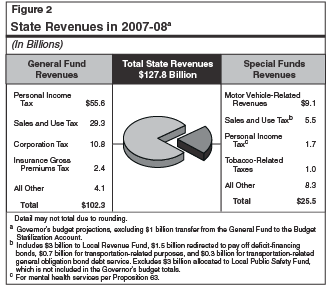
Sources of General Fund Revenues. Figure 2 indicates that about 94 percent of total General Fund receipts are attributable to the state’s “big three” taxes—the personal income tax (PIT), the sales and use tax (SUT), and the corporation tax (CT). The remainder is related to a variety of smaller taxes (including insurance, tobacco, and alcoholic beverage taxes), fees, investment earnings, and various transfers from special funds.
Although the budget does not include any major tax reforms, it does contain several proposals that would have significant impacts on state General Fund revenues. As shown in Figure 3, these proposals would generate $796 million in 2007-08 and include:
-
$506 million in new revenues from the approval of five amended gambling compacts with tribes that operate casinos in Southern California.
-
$290 million from several proposals affecting the state’s major taxes.
|
|
|
Figure 3
2007-08 General Fund Revenue Changes
Proposed in the Governor’s Budget |
|
(In Millions) |
|
|
Fiscal Impact |
|
|
2007‑08 |
2008‑09 |
|
Personal Income Tax |
|
|
|
Elimination of teacher tax credit |
$165 |
$170 |
|
Tax gap enforcement |
69 |
84 |
|
Sales and Use Tax |
|
|
|
Make permanent recent changes in treatment of
out-of-state purchases of vehicles, vessels, and aircraft |
$35 |
$35 |
|
Compliance measures |
12 |
12 |
|
Corporation Tax |
|
|
|
Tax gap enforcement |
$9 |
$10 |
|
Tribal Gambling |
|
|
|
Amended compacts |
$506 |
$506 |
|
Totals, 2007-08 Revenue Measures |
$796 |
$817 |
|
|
Regarding the latter proposals, the largest is the permanent elimination of the Teacher Retention Tax Credit. This PIT credit is available to credentialed teachers and ranges from $150 to $1,500 per claimant, depending upon their years of experience. The permanent elimination of the credit would result in a net increase in PIT revenues of $165 million in the budget year. This program was adopted in 2000, but has been suspended in each of the past three years and four out of the past six years, primarily due to budgetary considerations. A review of the credit appears in “Part V” of this volume.
The budget would also permanently extend current provisions relating to the application of the use tax on out-of-state purchases of vehicles, vessels, and aircraft. Legislation passed along with the 2004-05 Budget Act increased the period of time that such purchases have to be kept out of state in order to avoid the use tax from 90 days to one year. This revised requirement was scheduled to revert back to 90 days on July 1, 2006, but the one-year test was extended through July 1, 2007, by legislation passed along with the 2006-07 Budget Act. The Governor’s proposal would make permanent the one-year test for out-of-state purchases. This proposal is also reviewed in “Part V.”
In addition, the administration proposes funding of new auditing positions aimed at reducing the state‘s tax gap. These proposals, which are reviewed in the General Government section of our Analysis of the 2007-08 Budget Bill, are expected to result in increases of $69 million in PIT revenues and $9 million in CT revenues in 2007-08.
The updated budget forecast assumes that revenue growth will slow in 2006-07, and then rebound somewhat in 2007-08. The current estimate for 2005-06 and 2006-07 is up moderately from the 2006-07 Budget Act projections, mainly reflecting higher PIT collections. The budget’s General Fund revenue projections are summarized in Figure 4.
|
|
|
Figure 4
Summary of the Budget's General Fund Revenue
Forecast |
|
(Dollars in Millions) |
|
|
|
2006-07 |
|
2007-08 |
|
|
Actual
2005-06 |
Estimated Amount |
Percent Change |
|
Projected Amount |
Percent Change |
|
Taxes |
|
|
|
|
|
|
|
Personal income |
$49,877 |
$52,042 |
4.3% |
|
$55,598 |
6.8% |
|
Sales and use |
27,581 |
27,775 |
0.7 |
|
29,347 |
5.7 |
|
Corporation |
10,316 |
10,311 |
-0.1 |
|
10,816 |
4.9 |
|
Insurance |
2,202 |
2,220 |
0.8 |
|
2,354 |
6.0 |
|
Other |
467 |
469 |
0.4 |
|
475 |
1.1 |
|
Other Revenues, Transfers,
and Loans |
|
|
|
|
|
Other revenues |
$2,990 |
$2,343 |
-21.6% |
|
$3,073 |
31.2% |
|
Transfers |
-7 |
-170 |
— |
|
637 |
— |
|
Totals |
$93,427 |
$94,990 |
1.7% |
|
$102,300 |
7.7% |
|
|
|
Detail may not total
due to rounding. |
|
|
2005-06 Actual. The budget shows that 2005-06 General Fund revenues and transfers totaled $93.4 billion, a 13.6 percent increase from 2004-05. This revised estimate is up $678 million from the 2005-06 revenue forecast contained in the 2006-07 Budget Act. The increase relative to the 2006-07 Budget Act is primarily related to the timing of audit payments and other receipts, and is partly offset by a lower carry-in balance from 2004-05.
2006-07 Estimate. The administration’s forecast assumes that General Fund revenues and transfers will be $95 billion, a 1.7 percent increase from the prior year. The low growth rate reflects both economic factors—such as a slowdown in profits, taxable spending, and capital gains—as well as various one-time factors affecting the 2005-06 and 2006-07 revenue totals. Absent these one-time factors, the underlying growth rate is slightly higher, although still less than 3 percent. The current estimate is up $637 million from the 2006-07 Budget Act.
2007-08 Forecast. The budget forecasts that General Fund revenues and transfers will be $102.3 billion, a 7.7 percent increase from 2006-07. Adjusting for one-time factors in both the current and budget years, the underlying growth rate is about 6 percent, or slightly faster than the projected growth in the state’s economy.
Figure 5 shows our projections of General Fund revenues for 2006-07 through 2008-09. These projections are based on our economic and demographic forecasts presented in “Part II” of this volume and reflect the impacts of the Governor’s revenue-related policy proposals. For the current and budget years combined, we are estimating that General Fund revenues will fall below the budget forecast by $2 billion. We specifically forecast that:
-
In 2006-07, General Fund revenues and transfers will total $94.1 billion, a 0.7 percent increase from 2005-06. This is down $939 million from the budget forecast, reflecting a $1.3 billion decline in PIT receipts and a $95 million decline in SUT receipts, partly offset by a $429 million increase in CT revenues.
-
In 2007-08, General Fund revenues and transfers will total $101.3 billion, a 7.7 percent increase from the current year. This projected growth rate is affected by certain one-time factors, such as $300 million from an assumed refinancing of tobacco bonds (with the proceeds used to fund the first payment of a Proposition 98 settlement) and the flow and timing of rebate payments related to federal penalties involving child support automation. After adjusting for these effects, the underlying growth in revenues is around 6.5 percent, or modestly higher than personal income growth. Our forecast is down by slightly over $1 billion from the budget projection. A bit over one-half of the reduction is related to our assumptions about pension bonds and tribal gambling compacts, while the remainder is related to our lower forecasts of combined collections from the state’s major taxes.
-
In 2008-09, revenues and transfers will total $107.5 billion, an increase of 6.2 percent. Excluding various one-time factors, the underlying growth rate is slightly higher than 6.7 percent, or modestly above the projected growth in statewide personal income during the period.
|
|
|
Figure 5
Summary of the LAO’s General Fund Revenue Forecast |
|
(Dollars in Millions) |
|
|
Estimated
2006-07 |
|
Projected
2007-08 |
|
Projected
2008-09 |
|
|
Amount |
Percent
Change |
|
Amount |
Percent Change |
|
Amount |
Percent Change |
|
Taxes |
|
|
|
|
|
|
|
|
|
Personal
income |
$50,750 |
1.8% |
|
$54,810 |
8.0% |
|
$58,660 |
7.0% |
|
Sales and use |
27,680 |
0.4 |
|
29,130 |
5.2 |
|
30,850 |
5.9 |
|
Corporation |
10,740 |
4.1 |
|
11,400 |
6.1 |
|
12,140 |
6.5 |
|
Insurance |
2,250 |
2.2 |
|
2,351 |
4.5 |
|
2,469 |
5.0 |
|
Other |
459 |
-2.0 |
|
461 |
0.5 |
|
463 |
0.5 |
|
Other Revenues, Transfers
and Loans |
|
|
|
|
|
Other revenues |
$2,343 |
-21.6% |
|
$2,715 |
15.9% |
|
$2,350 |
-13.4% |
|
Transfers |
-170 |
— |
|
386 |
— |
|
550 |
— |
|
Totals |
$94,052 |
0.7% |
|
$101,253 |
7.7% |
|
$107,482 |
6.2% |
|
|
|
Detail may not total
due to rounding. |
|
|
Soft Year-End Receipts. The budget forecast is largely completed by the administration in early December, prior to when key information about year-end economic and revenue activity becomes available. A key element in the year-end revenue picture is the strength of PIT estimated payments. These payments are due on January 15 of each year, but a significant portion of them are paid in late December in order to take advantage of the federal income tax deduction allowed for state tax payments.
Estimated payments are related to volatile nonwage income sources, such as investment earnings and the pass-through of business profits to individuals. These year-end estimated payments have often been an early indicator of the strength of final PIT payments remitted in the forthcoming April.
As shown in Figure 6, these payments soared in 2004-05 and 2005-06. The administration assumed that the strength would continue in 2006-07, estimating a 17 percent increase during the year. However, actual receipts from these estimated payments were down slightly from the 2005-06 level. The actual level of receipts for December 2006 and January 2007 combined was $1.1 billion below the new budget forecast.
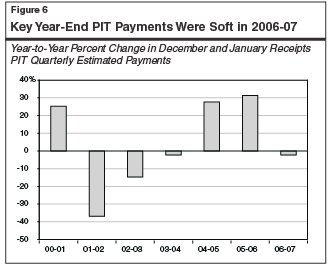
The softness in these payments was partly offset by stronger-than-expected year-end corporation taxes, which came in about $350 million above estimates. We also note that the administration’s forecast of final payments in April is somewhat conservative relative to last year. Thus, the year-end softness may not translate into a major weakness in April relative to the budget forecast. Nevertheless, the shortfall in year-end estimated payments from individuals is clearly a negative development in the outlook. Even allowing for higher trends in corporation taxes, we expect revenues from the state’s major taxes to fall below the administration’s updated forecast by over $900 million.
Lower Estimate for Governor’s Tribal Gambling Proposal. As noted earlier, the administration is assuming $506 million in new revenues from the amended tribal gambling compacts. We believe that this estimate is based on optimistic assumptions about both (1) the speed with which new slot machines would be put in place and (2) the amount of revenues generated per machine. We are assuming that, if approved, the compacts would yield no more than $200 million in 2007-08, or $306 million less than projected in the budget.
Pension Bonds Unlikely to Be Sold. The administration is also assuming that the state will sell a $525 million pension obligation bond to cover a portion of California government’s annual contribution to the public employment retirement system during the year. About one-half of this total ($252 million) would show up as revenues to the General Fund. (The balance would be reflected as an offset to General Fund expenditures.) We have not included these bond proceeds in our revenue or expenditure estimates for 2007-08 because of previous decisions at the superior court level. These courts have held that the pension obligation bonds violate the State Constitution’s prohibition against the creation of debt without voter approval.
As indicated above, the great majority of General Fund revenues are attributable to the state’s three major taxes—the PIT, SUT, and CT. The performance of these taxes will have a dominating influence on the overall revenue outlook. In the following sections, we discuss in more detail recent developments and the outlook for each of these key revenue sources.
The PIT is, by far, the state’s largest revenue source, accounting for 54 percent of total estimated General Fund revenues in 2007-08. In general, the PIT is patterned after federal law with respect to reportable types of income, deductions, exemptions, exclusions, and credits. Under the PIT, taxable income is subject to marginal rates ranging from 1 percent to 9.3 percent, with the top rate applying to taxable income in excess of about $87,000 for joint returns in 2006 (and one-half of that for taxpayers filing single returns). An additional 1 percent rate is imposed on the portion of incomes in excess of $1 million (for a total marginal rate of 10.3 percent for affected taxpayers). The proceeds of this surcharge, which was implemented following approval of Proposition 63 in November 2004, are allocated to a special fund to support various mental health programs.
We forecast that PIT receipts will total $50.8 billion in 2006-07, a 1.8 percent increase from the prior year. We also forecast that PIT receipts will increase by 8 percent, to $54.8 billion, in 2007-08 and by an additional 7 percent, to $58.7 billion, in 2008-09. Our revenue estimates assume the Governor’s proposal to eliminate the teacher tax credit, as well as the additional collections from audit activities directed at reducing the tax gap. Compared to the budget forecast, our current projection of PIT revenues is down by $1.3 billion in the current year, and by $788 million in 2007-08.
The main determinants of PIT collections in a given fiscal year are (1) the annual tax liabilities for the two income years falling within the fiscal year, and (2) the timing of the cash payments associated with these income-year liabilities—that is, withholding, quarterly estimated payments, final payments, and refunds. Both of these factors are pointing toward sluggish growth in PIT receipts in 2006-07.
Liability Growth. After growing by more than 15 percent in both 2004 and 2005, we estimate that PIT liability growth eased to 5.5 percent in 2006 (see Figure 7). The more subdued growth rate is consistent with the slowdown in California’s economy that occurred during 2006. The economic slowdown took a toll on real estate-related profits and capital gains during the year. Increases and decreases in these volatile earnings sources have a magnified effect on California’s income tax liabilities, since business-related profits and capital gains tend to accrue to high-income taxpayers, which are subject to California’s top income tax rates. We estimate that, after booming by 40 percent in 2005, capital gains fell by 5 percent in 2006.
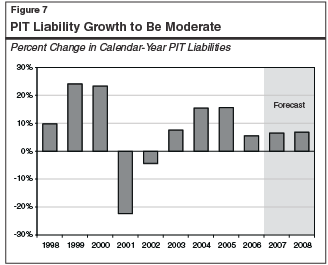
We project that PIT liabilities will then increase by 6.5 percent in 2007 and 6.8 percent in 2008. The projected increases are modestly greater than our forecast for personal income growth during these two years. This reflects the interaction of moderate real income growth with California’s progressive PIT tax rate structure, where rising incomes are subject to increasingly higher marginal rates. Our forecasts also assume that capital gains will partly rebound during the next two years, growing by 5 percent in 2007 and 8 percent in 2008.
Payment Patterns. Under state law, PIT taxpayers are required to make payments during the year that cover the lesser of (1) 100 percent of their prior-year liabilities or (2) 90 percent of their current-year liabilities. Given these requirements, taxpayers with nonwage income have historically made early quarterly estimated payments based on their prior-year liabilities, knowing that they will avoid penalties if they do so. During periods of significant liability growth, this strategy leads to large payments due when final returns are filed in April. Conversely, when liability growth falls off, taxpayers, basing their early prepayments on the higher prior-year earnings, find themselves with smaller payments due at the end of the year.
In the context of the recent and current PIT outlook, the jump in liabilities in 2005 resulted in a disproportionate increase in payments during 2005-06, since taxpayers with large increases in liabilities found themselves with substantial amounts owed when final payments were due in April 2006. Conversely, we believe that the slowdown in liabilities in 2006 will result in smaller final payments in April 2007 compared to last year.
The SUT is the General Fund’s second largest revenue source, accounting for just under 29 percent of estimated total revenues in 2007-08. The main SUT component is the sales tax, which is imposed on retail sales of tangible goods sold in California. Some examples of sales tax transactions include spending on clothing, furniture, computers, electronics, appliances, automobiles, and motor vehicle fuel. Purchases of building materials that go into the construction of homes and buildings are also subject to the sales tax, as are purchases of computers and other equipment used by businesses. Roughly 70 percent of SUT is remitted by retailers, while the remaining 30 percent is directly paid by businesses who themselves consume or use the products being taxed, such as office furniture and equipment. The largest exemption from the SUT is for most food items consumed at home. The great majority of services are not subject to the sales tax in California.
The second component of the SUT—the use tax—is imposed on products bought from out-of-state firms by California residents and businesses for use in this state. With the exception of purchases of automobiles, vessels, and aircraft (which must be registered), out-of-state purchases are difficult to monitor, and the state is prohibited under current federal law from requiring most out-of-state sellers to collect the use tax for California. As a result, use tax receipts account for only a small portion of total SUT revenues.
The total SUT rate levied in California is a combination of several different individual rates imposed by the state and various local governments. These include:
-
State Rate. The basic state SUT rate is currently 6.25 percent. The largest single component is the 5 percent state General Fund rate. Also included in the overall state rate are two half-cent rates whose proceeds are deposited into (1) the Local Revenue Fund, which supports health and social services program costs associated with the 1991 state-local realignment legislation, and (2) the Local Public Safety Fund, which was approved by the voters in 1993 for the support of local criminal justice activities. The final component of the state’s SUT rate involves Proposition 57. Under that measure, which was approved by the voters in March 2004, 0.25 percent of the Bradley-Burns rate (discussed later) is diverted to a state special fund for purposes of repayment of the deficit-financing bonds. These bonds were issued in 2004 to help deal with the state’s budget problem. (The diverted local sales taxes are being replaced by a shift of property taxes from schools, which are in turn reimbursed by Proposition 98 payments to schools by the state General Fund. As a result of these various steps, state government is ultimately responsible for the bonds’ repayment.) The diversion of sales tax revenues will remain in effect until the bonds are paid off, which the administration is proposing to do in 2009-10.
-
Uniform Local Rate. This is a uniform local tax rate of 1 percent levied by all counties (the so-called Bradley-Burns rate). Of this total, 0.25 percent is deposited into county transportation funds, while the remaining 0.75 percent is allocated to city and county governments for their general purposes. This latter rate will return to 1 percent once the deficit-financing bonds are paid off.
-
Optional Local Rates. The final overall SUT rate component involves optional local tax rates, which local governments are authorized to levy for any purpose. These taxes, which require local voter approval, are normally levied on a countywide basis—primarily for transportation-related purposes. They are generally levied in 0.25 percent or 0.5 percent increments and cannot exceed 1.5 percent in total (except in San Francisco and San Mateo Counties).
Combined SUT Rates Throughout California. The combined state and local SUT rate varies significantly across California geographically due to differences in the local optional rates that are levied (see Figure 8). The combined SUT rate currently ranges from 7.25 percent (for those counties with no optional rates) up to 8.75 percent. On a weighted-average basis calculated using the amount of taxable sales in different counties and their respective SUT rates, the statewide rate is currently 7.94 percent.
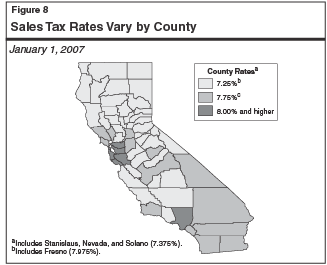
We forecast that SUT receipts will total $27.7 billion in 2006-07, a modest 0.4 percent increase from the prior year. Revenues from this source are projected to increase to $29.1 billion in 2007-08 (up 5.2 percent from the current year) and to $30.9 billion in 2008-09 (a 5.9 percent increase). Compared to the budget forecast, our SUT revenue estimate is down $95 million in 2006-07 and by $217 million in 2007-08.
The key factors behind our forecasted modest current-year growth in General Fund SUT collections are (1) sluggish increases in taxable sales and (2) large “spillover” transfers to transportation-related special funds.
Taxable Sales. This measure generally experienced strong growth in 2005 and early 2006, but then slowed sharply beginning in the third quarter of last year (see Figure 9). We believe that the slowdown has been primarily related to the decline in California’s real estate market and its impact on sales of building materials, home furnishings, and related household items. However, it was also related to the negative impacts of higher gasoline prices on consumer spending on big-ticket items, particularly light vehicles sales in the second half of last year. While California appears to have experienced a reasonably healthy holiday shopping season, the strength in this area was not sufficient to offset weakness related to housing and autos. Overall taxable sales increased by just 4.3 percent in 2006, the smallest growth rate since 2002.
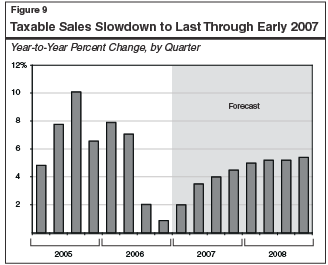
We forecast that taxable sales growth will remain subdued in the first quarter of 2007, mainly reflecting softness in housing-related activity. We expect that sales growth will then pick up beginning in the second quarter of 2007. Key factors behind the acceleration are: (1) the stabilization of housing markets, (2) the favorable effects of recent gasoline price declines on consumer confidence and spending on automobiles, and (3) a general improvement in job and income growth over the next year. On an annual basis, we forecast that taxable sales growth will average 3.5 percent in 2007 (with smaller increases in the first half and larger increases in the second half), before accelerating to 5.2 percent in 2008.
Spillover Transfer. A second factor depressing sales tax revenues to the General Fund in the current fiscal year is a larger-than-normal spillover transfer of sales taxes from the General Fund to the Public Transportation Account. This transfer is based on a formula established in the early 1970s that basically compares taxable sales of gasoline to taxable sales of all other products. Under this formula, the transfer increases when the share of total taxable sales that is attributable to gasoline increases. Thus, it is sensitive to both gasoline prices and consumption. In practice, the spillover has tended to increase during periods of high gasoline prices, and decrease or disappear during periods of low gasoline prices. This transfer was suspended in 2005-06 but is expected to be $562 million in the current year. We forecast that the transfer will decline to $454 million in 2007-08 and further to $395 million in 2008-09, based on our forecast for gasoline prices and consumption.
The CT is the third largest state revenue source, accounting for 11 percent of total estimated revenues in 2007-08. The tax is levied at a general rate of 8.84 percent on California taxable profits. Banks and other financial institutions subject to CT pay an additional 2 percent tax, which is in lieu of most other state and local levies. Corporations that qualify for California Subchapter “S” status are subject to a reduced 1.5 percent corporate rate. In exchange, the income and losses from these corporations are “passed through” to their shareholders where they are subject to PIT. Similarly, businesses that are classified as Limited Liability Companies (LLCs) pay a minimum tax and fee at the corporate level and their income and losses are passed through to their owners, where they are subject to the PIT.
Approximately two-thirds of all CT revenues come from multistate and multinational corporations. These companies have their consolidated U.S. income apportioned to California based on a formula involving the share of their combined property, payroll, and sales that is attributable to this state.
California’s CT allows for a variety of exclusions, exemptions, deductions, and credits, many of which are related to, similar to, or identical to those provided under the federal corporate profits tax. Key examples include the research and development tax credit and net operating loss carry forward provisions, whereby companies can use operating losses incurred in one year as a deduction against earnings in subsequent years. Under legislation enacted in 2002, corporations were not able to use these losses to offset their income in tax years 2002 and 2003. However, such deductions were allowed again beginning in 2004, and the percentage of losses which may be carried forward and deducted against future tax liabilities jumped from 65 percent under prior law to 100 percent for losses incurred starting in 2004.
After many years of near-stagnant growth, revenue collections from the CT grew rapidly between 2001-02 and 2005-06 (see Figure 10). These increases are consistent with the rapid growth experienced by other states and at the federal level, and coincide with major growth in reported taxable profits and recent increases in audit collections.
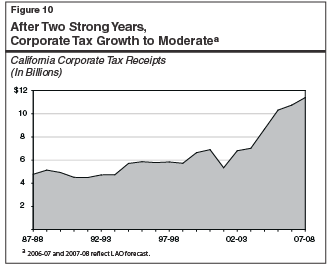
We forecast that CT receipts will be $10.7 billion in 2006-07, a 4.1 percent increase from the prior year. Thereafter, we forecast that revenues will grow to $11.4 billion in 2007-08 (a 6.1 percent increase), and further to $12.1 billion in 2008-09 (a 6.5 percent increase). Our estimates take into account our projected increases in business profits, as well as factors affecting audit collections. Our CT revenue forecast is above the budget estimate by $429 million for the current year and $584 million for the budget year.
The key determinant of CT tax revenues is California taxable profits. These profits were up 27 percent in 2004 and 32 percent in 2005, reflecting widespread earnings increases.
Recent Evidence Suggests Profits Grew Moderately in 2006. As shown in Figure 11, growth in CT payments subsided during the first three quarters of 2006, suggesting that profits eased during the year. However, as also shown, payments in the final quarter of the year rebounded, increasing by 15 percent from the final quarter of 2005. Based on these payments, we estimate that profits for the full year were up by around 8 percent from 2005. While less robust than for the two prior years, the 2006 performance was reasonably strong, particularly in view of the general economic slowdown that occurred in 2006.
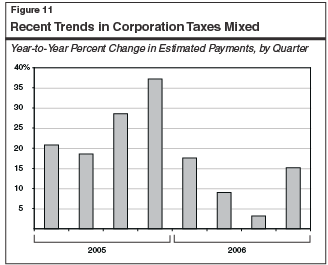
Further Slowing Expected. Looking ahead, we forecast that taxable California corporate profit growth will slow significantly to around 4 percent in 2007 before partly rebounding to 7 percent in 2008. The anticipated slowdown in 2007 is related to continued softness in the construction sector, real estate-related finance sectors, and manufacturing sectors related to home construction materials. The partial rebound in subsequent years is related to our assumption that overall sales and output will expand at a moderate pace in 2008 and beyond.
A significant risk to our CT forecast relates to two recent court decisions about California’s application of LLC fees. California imposes an annual $800 minimum annual tax plus an annual fee on LLCs doing business in California. The fee is based on a rate structure that takes into account the gross receipts of the business involved from all sources—both inside and outside of California. The state currently collects roughly $300 million from this fee.
During 2006, superior courts in two separate cases ruled that the LLC fee is unconstitutional. The lower courts specifically found that the LLC fee violates the due process and commerce clauses of the U.S. Constitution, because it is based on geographically combined (that is, nonapportioned) receipts of businesses—including receipts derived from their non-California operations. The state is appealing both of these rulings.
Last year, the Legislature passed a measure (AB 1614, Ruskin) which would have revised California’s LLC fee structure so that it would be based solely on receipts apportioned to California. The Governor vetoed the measure, however, citing the pending litigation.
Several outcomes to the litigation are possible. For example, under a worst-case scenario, if the state was to lose its appeals and the fee was invalidated, the state would no longer collect those revenues and companies could also file for refunds of fee payments made for 2001 onward. In this event, the revenue loss to the state could be over $1 billion. Alternatively, if the court simply required that the fee be based on apportioned income, the fiscal impacts would be much more modest, roughly $100 million.
The remaining 6 percent of total 2007-08 General Fund revenues and transfers consists primarily of taxes on insurance premiums, alcoholic beverages, and tobacco products. It also includes interest income and a large number of fees, loans, and transfers.
We forecast that combined revenues from all of these other sources will rise from $4.9 billion in 2006-07 to $5.9 billion in 2007-08, before falling slightly to $5.8 billion in 2008-09. These totals are affected by a variety of factors. For example, the increase between the current and budget year reflects (1) $300 million in transfers associated with the refinancing of a tobacco bond, (2) $200 million from the Governor’s proposal to amend five existing tribal gambling compacts and double the number of slot machines operated by them, and (3) one-time federal relief payments related to child support automation penalties. The portion of these other revenues related to taxes is expected to grow moderately between the current and budget year.
Special funds revenues are related to a variety of sources:
-
About $9.1 billion (or 35 percent of the budget-year total) is related to motor vehicle-related revenues. These include the vehicle license fee, which is assessed in lieu of the property tax and whose proceeds are distributed to local governments, mostly for their general purposes. They also include fuel taxes and registration fees, which support transportation-related spending.
-
Another $5.5 billion is related to the SUT. Of this total, (1) about $3 billion is used to fund health and social services programs that were realigned from the state to local governments beginning in the early 1990s, (2) $1.5 billion is related to the diversion of local sales taxes for deficit-financing bond debt service, and (3) about $1 billion is used for transportation programs.
-
Roughly $1.7 billion is related to the high-income PIT surcharge for mental health programs, which was approved by voters as Proposition 63 in November 2004.
-
$998 million is from tobacco taxes that have been approved by voters in various elections.
-
The remaining special funds revenues are related to a wide variety of sources, including an energy resource surcharge and beverage container redemption fees. The special fund totals are also affected by various transfers and loans between funds.
As shown in Figure 12, the Governor’s budget assumes that special funds revenues will total $24.7 billion in the current year (a 0.8 percent decline) and $25.5 billion in 2007-08 (a 3.4 percent increase). A variety of factors are affecting the year-to-year growth rates, including varying amounts of sales tax spillover revenues going to transportation and other transfers between funds. Special funds revenues from ongoing tax sources are projected to increase by roughly 3 percent in 2006-07 and 5 percent in 2007-08. The budget-year growth rate reflects moderate increases in sales taxes, vehicle license fees, and PIT, and modest increases in motor vehicle fuel and tobacco taxes.
|
|
|
Figure 12
Summary of the Budget's Special Funds Revenue
Forecast |
|
(Dollars in Millions) |
|
|
|
2006‑07 |
|
2007‑08 |
|
|
Actual 2005‑06 |
Estimated Amount |
Percent Change |
|
Projected Amount |
Percent Change |
|
Motor Vehicle Revenues |
|
|
|
|
|
|
|
License fees (in lieu) |
$2,229 |
$2,317 |
4.0% |
|
$2,408 |
3.9% |
|
Fuel taxes |
3,393 |
3,486 |
2.7 |
|
3,546 |
1.7 |
|
Registration, weight and miscellaneous fees |
2,812 |
2,912 |
3.5 |
|
3,099 |
6.4 |
|
Subtotals |
($8,434) |
($8,715) |
(3.3%) |
|
($9,053) |
(3.9%) |
|
Sales and Use Tax |
|
|
|
|
|
|
|
Realignment |
$2,845 |
$2,854 |
0.3% |
|
$3,017 |
5.7% |
|
Deficit-financing bonds |
1,420 |
1,424 |
0.3 |
|
1,511 |
6.1 |
|
Transportationa |
354 |
928 |
162.0 |
|
1,016 |
9.4 |
|
Subtotals |
($4,619) |
($5,206) |
(12.7%) |
|
($5,544) |
(6.5%) |
|
Other Sources |
|
|
|
|
|
|
|
Personal income tax
surcharge |
$1,343 |
$1,528 |
13.8% |
|
$1,694 |
10.9% |
|
Cigarette and tobacco taxes |
971 |
988 |
1.8 |
|
998 |
1.1 |
|
Interest earnings |
273 |
261 |
-4.5 |
|
301 |
15.2 |
|
Other revenues |
9,250 |
7,907 |
-14.5 |
|
8,245 |
4.3 |
|
Transfers and loans |
13 |
98 |
— |
|
-294 |
— |
|
Totals |
$24,903 |
$24,702 |
-0.8% |
|
$25,540 |
3.4% |
|
|
|
a Public
Transportation Account, transportation loan repayments, and debt
service. |
|
Detail may not total
due to rounding. |
|
|
Return to Perspectives and Issues Table of Contents,
2007-08 Budget Analysis